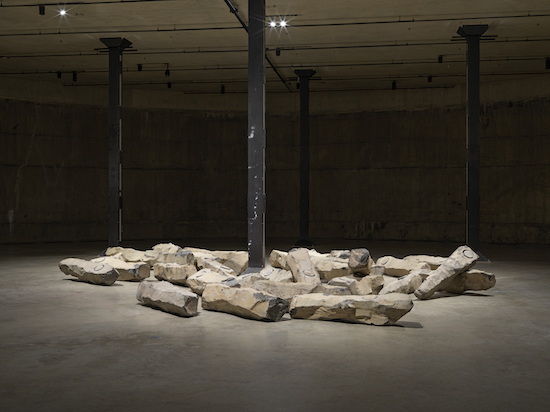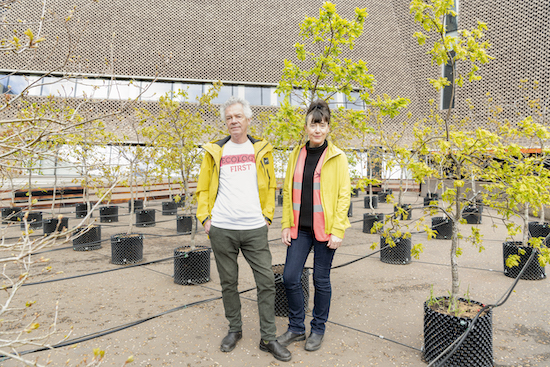Ralph Waldo Emerson was talking about history and the individual when he mentioned “the creation of a thousand forests in an acorn” but the phrase springs to mind when considering Ackroyd & Harvey’s project Beuys’ Acorns. 100 young potted oak trees are lined up in uniform rows on the Tate Modern’s South Terrace just outside the Blavatnik building. Their leaves are yellow green, their trunks can barely be described as such, yet they are the very image of potential.
The saplings began as acorns collected from trees that were originally part of 7000 Oaks, Joseph Beuys’ “social sculpture” for which 7000 oak trees, each accompanied by a large basalt stone, were planted between 1982 and 1987 in the German city of Kassel. Beuys, who was a co-founder of The Greens (which would later merge with the East German Alliance 90 to form the German Green Party), touted the project as “Stadtverwaldung statt Stadtverwaltung”: “city reforestation not city administration”. For the artist, it was a unique opportunity to foster interpersonal relationships between the citizens of Kassel, a city that had been heavily damaged in the Second World War, and their natural environment. These are lines of thought which Ackroyd & Harvey’s work also explores. “What we have to do is really get back to respect for the natural world and to realise that we are a part of it,” says Harvey.
Originally scheduled to open in 2020 to tie in with the gallery’s 20th anniversary celebrations (it was delayed due to the pandemic), the exhibition now coincides with the centenary of Beuys’ birth. Inside the gallery itself, which re-opens to the public on 17th May, Beuys’ The End of the Twentieth Century is installed in the Tanks directly beneath the trees on the terrace: thirty-one rough-hewn basalt blocks, four of which originally came from the 7000 Oaks rock pile in Friedrichsplatz, Kassel. “As above so below,” says Ackroyd on this reunion of sorts.
Ackroyd & Harvey are known for work that lies at the intersections of art, architecture, research, and activism. Ackroyd cites French author Jean Giono’s short allegory ‘The Man Who Planted Trees’ about one man’s efforts to reforest a desert (a book which she says, “led to a lot of informal planting”) as the inspiration for collecting the acorns back in 2007. She also recalls wanting to fight against the idea that “art is led by aesthetics and it has minimal incursion, effect or influence upon the political sphere.” The life and work of Beuys seemed to Ackroyd & Harvey to be anathema to that idea. 7000 Oaks embodied Beuys’ ethos of a more “social art”, art that could also be a catalyst for social change.
Describing the piece as a “living research project”, Ackroyd & Harvey tell me they have drawn from the work of biologists like Dr Roland Ennos on the “climate-proof[ing]” of cities through an increase in the number of trees. The artists have been exhibiting Beuys’ Acorns since 2009 with accompanying conversations with other artists, writers, scientists, activists discussing with a view to planting them permanently in the future. “This is specifically looking at planting within urban environments. It’s not about just increasing trees, per se, but trees within the urban environment,” says Harvey. Seven of the trees from this display will be planted locally in South London.

Joseph Beuys, The End of the Twentieth Century. Credit Tate Photography, Joe Humphrys
The display of the saplings at the Tate was also designed as a response to the climate crisis. In 2019, the gallery declared a climate emergency with Culture Declares Emergency, a group co-founded by Ackroyd & Harvey themselves in the same year, which has grown to have over 1600 “declarers” including institutions such as Somerset House, BFI, and Bristol Old Vic. Michael Raymond, the exhibit’s curator reflected on the declaration, explaining that announcing it when they did allowed them to “redouble our efforts in all areas” which has included looking into how to display Beuys’ Acorns in as sustainable a manner as possible. This involved creating an irrigation system for the plants that would be held together by wire as opposed to plastic cable ties. The trees are also protected from the public by a wooden barrier made of Larchwood sourced from a fallen tree in Croydon as opposed to FSC wood brought in from Europe, and the interpretative signage is made from recycled landfill waste. “I think the outcomes and some of the solutions that we’ve come up with are really good ones and I’m hopeful that we can share some of the lessons learned amongst colleagues at Tate – hopefully wider than that, across the sector, down the line.”
Keeping in tradition with other exhibitions of Beuys’ Acorns for which Ackroyd & Harvey invited other voices, the artists are also working with the poet and writer Ben Okri on a multi-day project with a performative element which is due to take place in June. On the collaboration, Harvey says: “it’s going to be grown, pelted almost, like when you grow grass from seed. Ben’s words will be stencilled into the grass and will be bright yellow when we take the stencils off.”
The wind occasionally bends the slender branches of the saplings of Beuys’ Acorns and the sight draws out a sense of protectiveness towards them, a feeling the artists and the curator also experienced. “I’ve never quite cut the umbilical cord,” says Ackroyd. What the display also allows for is the contemplation of time on a more epic scale than some of us may have done since perhaps the beginning of the pandemic when people were trying to read Boccaccio’s Decameron. Oak trees are a species quite slow to reach maturity and they live for an average of 150–250 years. It is hard not to think about the possibility that the saplings that somehow appear both vulnerable in the thrashing wind and resilient, will outlive the viewer. Beuys described a tree as a four-dimensional object, sculptural but also growing through time. This exhibition itself is, of course, temporary but Ackroyd & Harvey, aware not just of the legacy of Beuys’ urban forest, but of the threat to green spaces in cities, are also looking to longevity. They aim to have planted all the trees by 2027.


